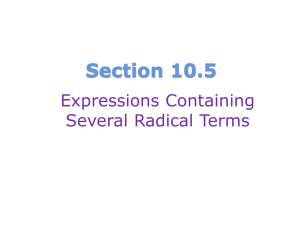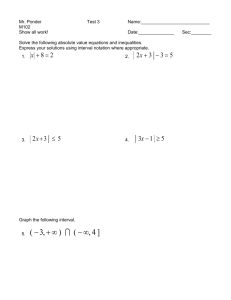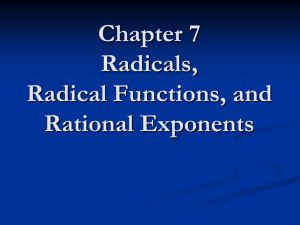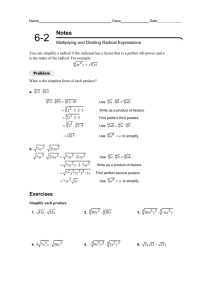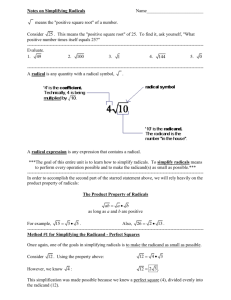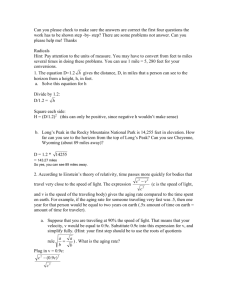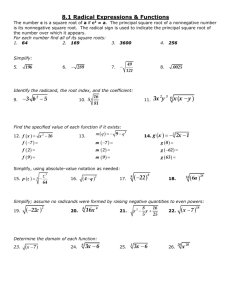Microsoft Word 97 - 2003 Document
advertisement
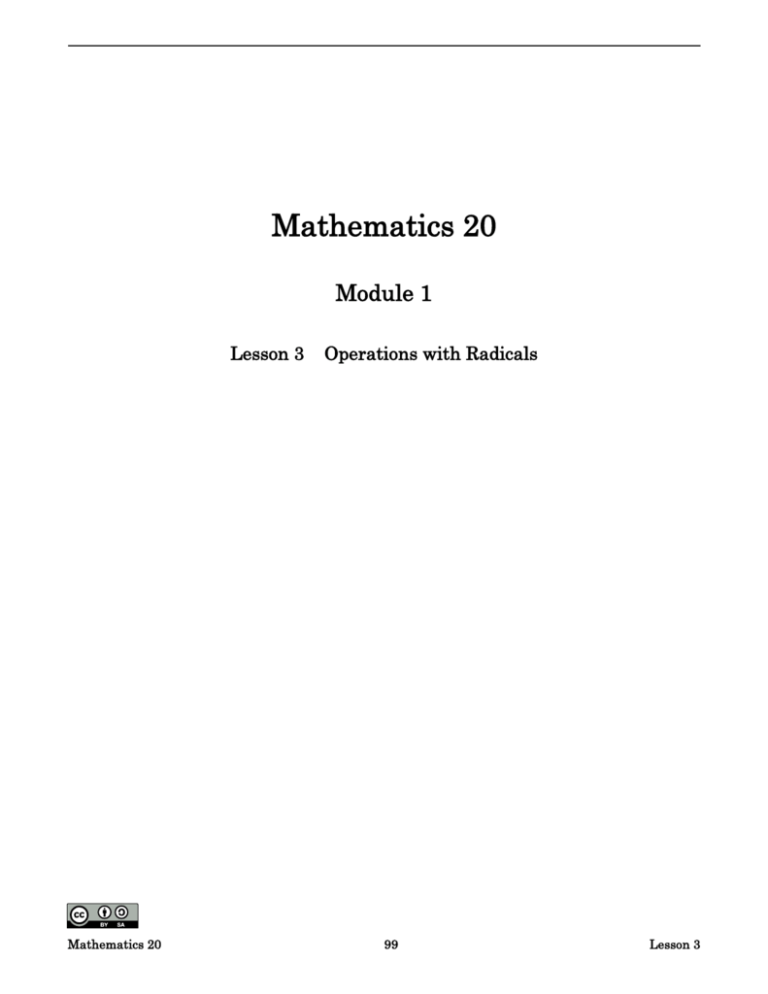
Mathematics 20 Module 1 Lesson 3 Mathematics 20 Operations with Radicals 99 Lesson 3 Mathematics 20 100 Lesson 3 Operations with Radicals Introduction This lesson continues with the study of square root radicals. In particular, the algebraic operations and equations involving radicals are studied and then applied to related practical problems. Whole Number Math • How many squares are contained in a 6 by 6 square grid? • Try with smaller size square grids to see if you can find a pattern. • See the summary at the end of the lesson for the solution. Mathematics 20 101 Lesson 3 Mathematics 20 102 Lesson 3 Objectives After completing this lesson, you will be able to • add, subtract, multiply, and divide square root radicals. • solve and verify radical equations containing one radicand. • solve problems that involve equations which contain radicals. Mathematics 20 103 Lesson 3 Mathematics 20 104 Lesson 3 3.1 Addition and Subtraction of Radicals In the study of polynomials, two terms are called "like" terms if the variables and the exponents of the variables are the same. For example: • the terms 2 x 2 and 16 x 2 are "like" terms • the terms 2 x and 16 x 3 are not "like" terms The situation with square root radicals is the same. Two square root radicals are called "like" radicals if the radicands are the same. Therefore: • the radicals 2 3 and 6 3 are "like" radicals • the radicals 3 are not "like" radicals 6 and Just as with polynomials, "like" radicals can be combined by addition and subtraction. Part of simplifying radical expressions is combining all the "like" terms. Example 1 Simplify 4 3 + 7 5 3 + 3 5 . Solution: Write the original expression. 4 3+ 7 5 3+ 3 5 Combine like radicals. = 4 3 3+7 5+ 3 5 Simplify. = 3 3 + 10 5 Since Mathematics 20 3 and 5 are not "like" radicals, no further simplification can occur. 105 Lesson 3 The distributive property is also used when simplifying radical expressions. The same rules apply as when working with polynomials or rational expressions. The Distributive Property The product of a and (b c) is given by: a(b c) ab ac or (b c)a ba ca . The product of a and ( b c ) is given by: a(b c) ab ac or (b c)a ba ca . Example 2 Simplify the radical expression 2( 5 3 ) 7(3 3 2 5 ) . Solution: Write the original expression. 2( 5 3 ) 7(3 3 2 5 ) Apply the distributive property. = 2 5 2 3 21 3 + 14 5 Group the "like" terms. = 2 5 + 14 5 2 3 21 3 Combine "like" terms. = 16 5 23 3 Radicals such as 75 and 6 3 do not appear to be "like" radicals. In this case, it is necessary to change 75 to a mixed radical. • 75 = 25 3 = 25 3= 5 3 6 3 and 5 3 now become "like" radicals. Mathematics 20 106 Lesson 3 Example 3 Simplify the expression 18 + 6 2 50 3 8 by first changing all of the radicals to the simplest possible mixed radical form. Solution: Change each radical to the simplest possible mixed radical form. • 18 = 9 2 = 3 2 • • • 6 2 is in its simplest form 25 2 = 5 2 50 = 3 8 = 3 4 2 = (3 2) 2 = 6 2 Write the original expression. 18 + 6 2 50 3 8 Express in simplest mixed radical form. = 3 2 + 6 2 5 2 6 2 Combine like terms. = (3 + 6 5 6 ) 2 Simplify. = 2 2 Example 4 Simplify 6 x + 5 x x x and then evaluate for x = 16 . Solution: Write the original expression. 6x + 5 x x x Change each radical to a mixed radical. = Combine the like terms. = ( 6 + 5 x) x Substitute x = 16 . 6 x + 5 x x x = ( 6 + 5 16 ) 16 Simplify. = ( 6 11 )4 Apply the distributive property. = 4 6 44 The Mathematics 20 6 and 44 are not "like" and cannot be further combined. 107 Lesson 3 Exercise 3.1 1. Simplify. a. b. c. d. e. 2. d. e. 6 2 3 + 4 3 1 + 6 3 3 + 7 4 + 6 3 3 25 2 5 + 7 6 + 9 6 5 + 3 6 3 1 3 3 8 2 + 3 + 10 2 3 4 7 2 + 3 + 5 4 2 3 3 5 Simplify. a. b. c. d. 4. 3 2 3 + 3 7 10 7 + 6 7 6 3 6 1 3+ 3 3 1 3+ 3 5 Simplify. a. b. c. 3. 6 4 9 5 2 5 4 1 1 1 4 3 5 + 6 5 2 3 4 2 2 3( 2 + 8 3 ) (3 2 24 3 ) 2( 9 6 3 ) 3( 16 12 3 ) 2 25 + 100 5(2 2 36 ) Simplify. a. b. c. d. e. f. g. h. i. 8 32 + 2 2 18 + 50 27 + 48 2 3 50 + 75 5 3 80 20 45 4 8 + 2 50 + 3 18 54 8 24 + 7 6 2 125 3 80 + 2 20 5 99 7 11 + 44 Mathematics 20 108 Lesson 3 5. Prove that x + y = x + y is false by finding just one set of values for x and y for which the equation does not hold. 6. Simplify. Assume that all variables are non negative. a. b. c. d. 2 a 6 a + a 5x b 3x b 7x b 100 x + 9 x 144 x 2 2 x +x+ 3 x e. x x+ f. x x 2 y 2 + x 2 y + yx g. 2 x + 2 3 x x 4 x x 2 9 x2 3.2 Multiplication of Radicals In the previous lesson the multiplication of two square root radicals was defined. Multiplication of Radicals a b = ab , for a 0, and b 0 The radicals do not have to be "like" radicals to be multiplied. The usual rules of algebra such as the commutative and distributive laws apply for radicals. When multiplying radicals, you can group the radicals and group the non radical coefficients. Each of these are then multiplied separately and then combined. Mathematics 20 109 Lesson 3 Example 1 Simplify the radical expression 3 5 7 2 . Solution: Write the original expression. 3 5 7 2 Group the radicals and group the non radical coefficients. = (3 7 )( 5 Multiply. = 21 5 2 2) = 21 10 Example 2 Use the distributive law to find the product and simplify 3 3 (7 2 + 8 6 ) . Solution: Write the original expression. 3 3 (7 2 + 8 6 ) Distribute 3 3 . = (3 3 7 2 ) + (3 3 8 6 ) Multiply coefficients and radicals. = (3 7)( 3 2 ) + (3 8)( 3 6 ) Simplify. = 21 6 + 24 18 = 21 6 72 2 Since the radicals are not “like” radicals, no further simplification is possible. It is useful to simplify each radical to simplest form first so that the radicands do not become too large. Mathematics 20 110 Lesson 3 Example 3 Simplify 2 2 (3 8 5 18 ) . Solution: Change each radical to the simplest possible mixed radical form. • 2 2 is in its simplest form • 3 8 3 4 2 (3 2) 2 6 2 • 5 18 5 9 2 (5 3) 2 15 2 Write the original expression. 2 2 (3 8 5 18 ) Express in simplest mixed radical form. = 2 2 (6 2 15 2 ) Combine radicals by subtraction. = 2 2 ( 9 2 ) Multiply coefficients and radicals. = ( 2 )( 9 ) 2 2 Simplify. = 18 (2) = 36 Mathematics 20 111 Lesson 3 Activity 3.2 Sometimes patterns are very helpful in mathematical problem solving. The following table has been started for you. Complete the table by determining the pattern that can be used when multiplying two identical radicals together. Like Radicals Multiply Solution 1 1 1 1 1 2 2 2 2 2 3 3 3 3 3 5 5 5 5 7 7 7 7 10 10 25 25 93 93 What pattern can you see? Multiplication of Like Radicals x x x Radical expressions can also be in the form ( a + b )( c + d ) . These two factors are multiplied in the same way that two binomials are multiplied. ( a + b )( c + d ) = ( a + b )c + ( a + b )d = ac + bc + ad + bd Mathematics 20 112 (a + b ) is distributed. c and d are distributed. Lesson 3 Another method to use when multiplying a binomial by a binomial is the FOIL method. Multiply the: O I L F First terms of the binomials. Outside terms of the binomials. Inside terms of the binomials. Last terms of the binomials. Example 4 Simplify ( 5 2 )( 2 5 + 3 2 ) . Solution: Use the foil method. Multiply the: • First terms ( 5)(2 5 ) = 2 5 5 = 2(5) = 10 • Outside terms ( 5)(3 2 ) = 3 5 2 = 3 10 • • Inside terms Last terms ( 2 )( 2 5 ) = 2 2 5 = 2 10 ( 2)(3 2 ) = 3 2 2 = 3(2) = 6 Write the original expression. Multiply using FOIL. Simplify. = ( 5 2 ) (2 5 3 2 ) = 10 + 3 10 2 10 6 = 4 + 10 Example 5 Simplify (3 5 1) (3 5 1) . Solution: Use the foil method. Mathematics 20 113 Lesson 3 Multiply the: • First terms (3 5 ) (3 5 ) = 9 5 5 = 9(5) = 45 • Outside terms (3 5 ) ( 1) = 3 5 • • Inside terms Last terms (3 5)( 1) = 3 5 (1) (1) = 1 Write the original expression. Multiply using FOIL. Simplify. = (3 5 1) (3 5 1) = 45 3 5 3 5 1 = 45 1 = 44 You should have noticed that this question was in the form of a difference of squares where the answer is the “square of the first term minus the square of the last term.” Exercise 3.2 1. Simplify each product of two mixed radicals. a. 6 7 b. 7 7 6(5 3 ) c. (4 3 )( 2 6 ) d. (2 9 )( 2 16 ) e. f. g. h. i. j. 2. (2 6 )( 3 8 ) (3 8 )( 2 18 ) ( 12 ) 2 (2 6 ) 2 ( ab )( cd ) Simplify. ( 3 5)( 3 + 5) a. (2 3 + 1)( 2 3 + 1) b. ( 2 + 3 )( 2 + 3 ) c. (1 2 5 )(1 + 2 5 ) d. (2 3 3 2 )( 2 3 + 3 2 ) e. Mathematics 20 114 Lesson 3 3. (2 5 2 ) 2 f. g. (2 7 49 )( 2 7 + h. (2 x )( 4 + 2 x ), x > 0 49 ) Can you see a pattern? a. b. c. What must 3 be multiplied by to get 3? What must 6 5 be multiplied by to get 30? What must c b , b> 0 , be multiplied by to get cb? 4. Can you see a pattern? a. Which expression must 5 2 be multiplied by to get 5 2 ? i) 5 2 , or ii) 5 2 b. Which expression must 7 5 be multiplied by to get 7 5 or 2? i) 7 5 , or ii) 7 5 3.3 Division of Radicals The rule for division of radicals: Division of Radicals a b = a , for a 0 and b > 0 b Just as for multiplication the radicals do not have to be "like" radicals to divide. Mathematics 20 115 Lesson 3 Example 1 Simplify 8 2. Solution: Write the original expression. Simplify using the rule for division. = = = = 8 8 2 8 2 4 2 2 Another way to simplify division is to change each radical to simplest mixed radical form first and then eliminate common factors. The same example will be used to illustrate this. Example 2 Simplify 8 2. Solution: Change each radical to the simplest possible mixed radical form. • • 8= 4 2= 2 2 2 is in its simplest form Write the original expression. = Express in simplest mixed radical form. = 2 2 2 2 Simplify by eliminating common factors. Mathematics 20 8 8 2 = 2 116 Lesson 3 In division, radicals often occur in the denominator. Such expressions are not in simplest form. Changing an expression with a radical in the denominator to an equal form with no radical in the denominator is called rationalizing the denominator. The following steps in the first example will illustrate how this is done. Example 3 Simplify 3 . 5 • • In the expression 3 the denominator can be rationalized by multiplying both the 5 numerator and the denominator by 5 . 5 This does not change the expression because = 1 and multiplication by 1 5 changes nothing. Solution: 3 Write the original expression. Rationalize the denominator. = Simplify. = 5 3 5 5 5 15 5 Notice that now the denominator does not have a radical in it and is therefore in simplest form. Mathematics 20 117 Lesson 3 Example 4 Simplify 7 6 by rationalizing the denominator. 3 5 Solution: 7 6 Write the original expression. Multiply numerator and denominator by 5. = 3 5 7 6 3 5 7 30 = 3(5) Simplify. = 5 5 7 30 15 Example 5 Simplify 3+ 2 5 by rationalizing the denominator. 3 Solution: 3+ 2 5 Write the original expression. Multiply numerator and denominator by 3. = 3 3+ 2 5 3 Apply the distributive property. = 3 3 3 + 2 15 3 Exercise 3.3 1. Simplify by rationalizing the denominator. a. b. 4 2 7 2 3 3 7 Mathematics 20 118 Lesson 3 1 c. 3 2 3 d. 27 5 e. 2 2 2 3 f. 2. Rationalize the denominator in each case. 7+ a. 5 2 2 3+ 6 5 b. 3 c. d. 10 6 5 2 5 1 7 3 e. 3 2 3 2 5 3. Simplify. Assume all variables are positive. a. bx b. 4 x2 y 2 xy c. 8 x3 d. a b b a 3 1 8 2 e. Mathematics 20 x 2x Hint: Simplify and then find a common denominator. 119 Lesson 3 3.4 Radical Equations and Problem Solving A radical equation is an equation in which the variable is part of the radicand. Some examples are: • x= 5 • 2 + x 5 = 7 • 3 x 3 = x + 1 x As usual, the method of solving an equation is to isolate the variable. This is also true in a radical equation. Once the radical has been isolated, the next step is to remove the radical sign. Squaring the radical removes the radical sign. Squaring a Radical • To remove a radical sign, square the radical. Example: 2 2 2 = 2= 2 2= 4= 2 In general: n 2 =n Example 1 Simplify a. 3 2 b. 3 5 2 c. 2 x+ 1 . Solution: a. b. c. 3 = 3 3 5 = 3 5 = 9 x + 1 = x + 1 2 2 Mathematics 20 2 2 5 = 45 2 120 Lesson 3 To solve a radical equation, the radical must be isolated first and then both sides of the equation are squared. Recall that whatever is done to one side of the equation must be done to the other side. It is also very important to include a check when solving equations and even more important when solving radical equations. A root that does not work when substituted back into the original equation is called an extraneous root. Example 2 Solve the radical equation x 11 3 . Solution: Write the original equation. x 11 3 Isolate the radical. x 3 11 x 8 x (8 ) Square both sides. 2 Simplify. 2 x 64 Check the solution by substituting the root into the original equation. x 11 = 64 11 = 8 11 = 3 = Mathematics 20 121 3 3 3 3 () Lesson 3 Example 3 Solve x = 5 . Solution: Write the original equation. x 5 Multiply both sides of the equation by 1 . x 5 x 5 Square both sides. 2 Simplify. 2 x 25 Check the solution by substituting the root into the original equation. x 5 25 5 5 5 () Example 4 Solve x 5 . Solution: x 5 This has no solution because equal a negative. x is a principal root and is positive. A positive cannot Example 5 Solve x 8 0 . Solution: Write the original equation. Isolate the radical. Square both sides. Simplify. x 8 0 x 8 x 8 x 64 2 2 Check the solution by substituting the root into the original equation. 64 8 0 8 8 0 16 0 Since the root does not check, it is called extraneous and this equation has no solution. Mathematics 20 122 Lesson 3 Example 6 Solve x + 7 = 12 2 x . Solution: Write the original equation. x + 7 = 12 2 x Isolate the variable by collecting similar terms. x + 2 x = 12 7 Simplify. 3 x 5 3 x (5) Square both sides. 2 2 9 x = 25 25 x= 9 Check the solution by substituting the root into the original equation. x + 7 = 12 2 x 25 + 7= 9 5 + 7= 3 5 21 + = 3 3 26 = 3 25 9 5 12 2 3 36 10 3 3 26 () 3 12 2 Example 7 Solve 3x 5 = 3x + 7 . Solution: Write the original equation. Square both sides. 3x 5 = 3x 5 Simplify. 2 = 3x + 7 3x + 7 2 3x 5 = 3x + 7 5 = 7 Since this is a false conclusion, the equation has no solution. Mathematics 20 123 Lesson 3 Exercise 3.4 1. Determine which is a solution to x 2 = x 1 + 1 x = 5 or x = 2 . 2. 3. Solve for x and check your solution. a. x=7 b. x+ 2= 3 c. x = 3 d. 2 x + 6 x = 30 2 x e. 2 x 1 = 9 x + 15 f. x 7 = 2 2 g. 3 x 5 = 13 h. 5x = i. 2x + 1 = j. 3x 5 = Explain why Mathematics 20 2x 7 5x + 7 3x + 5 x = 2 has no solution. 124 Lesson 3 Conclusion In the introduction you were given a Whole Number Math problem. The solution to the problem is: • Square Number 6 by 6 1 5 by 5 4 4 by 4 9 3 by 3 16 2 by 2 25 1 by 1 36 Total 91 There are 91 squares contained in a 6 by 6 square grid. Mathematics 20 125 Lesson 3 Summary The following is a list of concepts that you have learned in this lesson. • Radical expressions are added or subtracted by combining "like" radicals. Like radicals are radicals with the same radicand. • Radicals are multiplied by multiplying the radicands together in the radical sign. • • • a b ab , for a 0, and b 0 For a quotient of radicals a monomial denominator is rationalized by multiplying the numerator and denominator by the radical part of the denominator. a b = a , for a 0 and b > 0 b • To remove a radical sign, square the radical. • Equations which contain radicals can be solved by first isolating the radical and, then, squaring both sides. • The solution for radical equations must always be checked to eliminate extraneous roots. • An equation such as x = 2 has no solution since the left side is a principal root. Radicals in which the radicand is negative have no solution in the real number system since the product of two equal real numbers is always non negative. Mathematics 20 126 Lesson 3 Answers to Exercises Exercise 3.1 1. a. b. c. d. e. 2. a. b. 3. 6 1 2 3 4 3 6 3 5 + 8 3 3 14 6 3 15 3 6 3 14 15 7 3 1 c. d. 4 5 + 10 6 e. 3 2 2 3 a. 2 3 5 3 5 3 2 3 3 5 3 5 3+ 2 5 b. 3 2 24 3 3 2 24 3 6 2 c. 2(3 6 3 ) 3(4 12 3 ) 6 12 3 12 36 3 24 3 6 d. Mathematics 20 5 3 0 7 0 6 6 15 2 5 3 3 2 3 6 6 6 9 1 3 20 4 9 3 3 8 2 10 2 12 12 1 1 3+ 2 2 12 2(5) 10 10 2 ) 5(6 ) 10 10 10 2 30 50 10 2 127 Lesson 3 4. a. 4 2 16 2 2 2 2 4 2 2 2 b. c. 11 2 d. e. 5 2 f. 4 4 2 2 25 2 3 9 2 8 2 10 2 9 2 27 2 g. h. 6 6 i. 5. 9 3 16 3 2 3 3 3 4 3 2 3 5 3 16 5 4 5 9 5 4 5 2 5 3 5 5 2 25 5 3 16 5 2 4 5 10 5 12 5 4 5 2 5 10 11 Let x = 9 and y = 16 . ? 9 16 9 16 ? 3 4 25 75 There are many other values for which this is false. Mathematics 20 128 Lesson 3 a. b. c. d. e. 3 a 5x b 10 x 3 x 12 x x 5x f. x x y x2 y y x x x2 y x2 y x2 y 3 x2 y g. 4x Exercise 3.2 1. a. b. c. d. e. f. g. h. i. j. 42 49 7 30 3 8 18 24 2 48 (2 6 )( 6 2 ) 12 12 24 3 (6 2 )( 6 2 ) 36 4 72 12 24 abcd 2. a. b. c. d. e. 9 5 3 5 3 25 22 4 9 2 3 2 3 1 13 + 4 3 5+ 2 6 1 4 25 19 4 9 6 6 6 6 9 4 12 18 6 f. g. 22 4 10 21 h. 8 4 x 4 x 2 x2 8 2x 6. 3. Mathematics 20 a. b. c. x x x x 2 x2 x x x x x 2x x 0 3 5 b 129 Lesson 3 4. a. b. Exercise 3.3 1. a. b. c. d. e. f. 2. 4 14 7 2 3 7 2 21 21 3 7 7 3 3 2 3 2 3 3 2 9 2 3 3 3 3 3 3 9 3 5 2 4 6 3 14 + 2 a. b. c. d. e. 3. 5+ 2 7 5 a. b. c. d. e. (2 3 6 5 ) 3 3 3 2 9 6 15 3 6 6 15 3 2 2 15 10 6 5 5 10 5 30 5 3 10 2 5 5 3 21 21 3 3 3 10 15 10 b 2 x 4 x2 2x 1 3 2 2 Mathematics 20 10 1 2 3 2 2 2 2 2 130 1 2 2 2 4 Lesson 3 Exercise 3.4 1. 2. By substitution, the solution is 5. a. b. c. d. 3. Mathematics 20 ? ( x ) 2 (7) 2 x 49 check : ( x ) 2 (1) 2 x= 1 49 7 7 7 (3 ) ? check : 1 2 3 ? 1 2 3 3 3 (3 ) no solution 10 x (10 x ) 2 100 x x ? check : 2 9 6 9 30 2 9 30 (30 ) 2 900 9 e. no solution f. x = 15 g. ( 3 x 5 ) 2 13 2 3 x 5 169 3 x 174 x 58 ? 6 18 30 6 24 24 (3 ) ? check : 3(58 ) 5 13 ? 169 13 13 13 (3 ) h. x 4 i. no solution (The radicand cannot be negative.) j. no solution x is the principal root which is positive and cannot equal a negative. 131 Lesson 3 Mathematics 20 132 Lesson 3 Mathematics 20 Module 1 Assignment 3 Mathematics 20 133 Lesson 3 Mathematics 20 134 Lesson 3 Optional insert: Assignment #3 frontal sheet here. Mathematics 20 135 Lesson 3 Mathematics 20 136 Lesson 3 Assignment 3 Values (40) A. Multiple Choice: Select the best answer for each of the following and place a () beside it. 1. The simplified form of a. b. c. d. 2. 3. 4 2 2 2 3 9 3 81 If 5 x = 25 , then x is equal to ***. a. b. c. d. Mathematics 20 (2) 2 is ***. If 3 x 2 27 , then x is equal to ***. a. b. c. d. 4. 4 2 2 4 The simplified form of a. b. c. d. 2 2 is ***. 5 5 25 25 137 Lesson 3 5. If 2 x 1 = 7 , then x is equal to ***. a. b. c. d. 6. The simplified form of 2 2 + 5 2 7 2 is equal to ***. a. b. c. d. 7. 0 2 2 14 2 The simplified form of 3 2 5 2 3 4 5 is ***. a. b. c. d. 8. 49 4 25 5 3 10 23 27 To rationalize the denominator in the expression 2 3 , it is best to 7 5 multiply the numerator and denominator by ***. a. b. c. d. 9. The simplified form of 7 8 3 12 13 2 + 5 3 is ***. a. b. c. d. Mathematics 20 5 7 5 3 7 5 2 3 15 2 7 3 2+ 3 4 4 8 5 138 Lesson 3 10. The rationalized form of 2 is ***. 5 a. b. c. d. 11. 12 cm 2 3 cm 2 3 3 cm 2 12 3 cm 2 The surface area of a sphere with radius r is S = 4 r 2 . The equation with the radius isolated is ***. a. b. c. d. Mathematics 20 10 2 5 5 The formula for the area of an equilateral triangle with sides of length 2 s 3 s is A = . If each side is of length 4 3 cm , the area is ***. 4 a. b. c. d. 12. 5 2 2 5 2 5 S 4 2 r= S 2 16 1 S r= 2 r= r= 4 S 139 Lesson 3 13. The distance between two points (a, b ) , (c, d ) on a plane is ( c a ) 2 ( d b) 2 . The distance between (0 , 0 ) , and ( 3 , 7 ) is ***. a. b. c. d. 14. The solution to 2 3 x = 18 is ***. a. b. c. d. 15. 27 0 27 non existent The solution to a. b. c. d. 16. 4 2 10 2 29 58 b. c. d. 1 + 2 x is ***. non existent 0 1 3 The solution to a. 2x + 5 = 1 = 8 is ***. x 1 64 64 2 2 1 2 2 17. The irrational number 2.236068... is between the rational numbers ***. a. b. c. d. Mathematics 20 2.235 and 2.236 2.236 and 2.237 2.23 and 2.235 2 .236 and 2.236 140 Lesson 3 18. The number a. b. c. d. 19. c. d. 2 2 x + y is ***. 2 x + x+y y 2 ( x y) 2 none of the above The simplified form of a. b. c. d. Mathematics 20 rational an integer a negative irrational a real number Another form of a. b. 20. 3 is ***. 3 x , x > 0 is ***. x x x x x+x+x 3 x 141 Lesson 3 Mathematics 20 142 Lesson 3 Part B can be answered in the space provided. You also have the option to do the remaining questions in this assignment on separate lined paper. If you choose this option, please complete all of the questions on the separate paper. Evaluation of your solution to each problem will be based on the following. • A correct mathematical method for solving the problem is shown. • The final answer is accurate and a check of the answer is shown where asked for by the question. • The solution is written in a style that is clear, logical, well organized, uses proper terms, and states a conclusion. (40) B. (4 each) Mathematics 20 1. Simplify 3 5 4 3 3 5 + 6 3 . 2. Simplify 3 50 32 + 5 200 . 143 Lesson 3 Mathematics 20 3. Simplify 2 3 5 3 3 2 5 . 4. Simplify 1 3 5 . 5. Simplify 7 b 2 5 4 b 2 + 4 b, b > 0 . 6. Simplify 2 3 5 2 2 3 2 2 2 14 2 . 144 Lesson 3 7. Rationalize the denominator in the expression 4 . 15 8. Rationalize the denominator in the expression 3+ 7 2 . 2 2 9. 10. Mathematics 20 Find all the solutions to x 2 5 = 95 . Find the solution to the equation 2 3 5 x = 34 and provide a check. 145 Lesson 3 C. (8) 1. The community of Melfort is planning to build a circular wading pool in the park. The pool will cover an area of 1000 m2. The building committee has decided to put a 5 m cement pad around it. How much additional area will the cement pad take up? (Remember A r 2 .) Use all of the steps for problem solving. (12) (3 each) 2. Mathematics 20 Provide a table of values and draw the graphs of each of the following equations, each on a separate grid supplied on the following pages. a. y b. y x c. 2 y x d. y x x 1 146 Lesson 3 C. 2. a. y x x b. y x x Mathematics 20 y y 147 Lesson 3 . 2. c. y2 x x d. y x y x 1 y 100 Mathematics 20 148 Lesson 3


